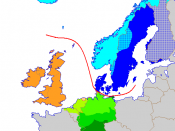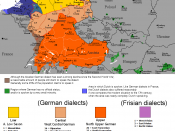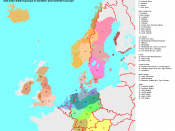GERMANIC LANGUAGES
Present and earlier forms of German, English, Dutch-Flemish, Afrikaans,
Yiddish, Frisian, Danish, Norwegian, Swedish, Icelandic, and Faeroese belong
to the family of languages called Germanic. These languages are a branch of
the Indo-European language family. Of these, English has the largest number of
speakers, considerably more than 300 million.
For some language families there are written records of the parent
language. The Romance languages, for example, are derived from Latin. But in
the case of the Germanic family, there are no records of the parent language,
called by linguists Proto-Germanic. There are, however, historical evidences
of Germanic provided by isolated words and names recorded by Latin authors
beginning in the 1st century BC, and after AD 200 there are Scandinavian
inscriptions. The earliest extensive Germanic text is the Gothic Bible,
translated by Bishop Ulfilas in about AD 350. Like every language spoken over
a large geographical area, Proto-Germanic presumably consisted of dialects
that developed into the modern Germanic languages.
The original Germanic peoples were located in southern Scandinavia and
along the North Sea and Baltic coasts from what is now The Netherlands to
present-day Poland. During the early years of the Roman Empire they gradually
spread southward through present-day Germany, Austria, and parts of
Switzerland. Some tribes conquered the British Isles, Iceland, and the Faeroe
Islands north of Scotland.
German is the national language of Germany and Austria, and it is one of
the three national languages of Switzerland. There are also German-speaking
communities in North America, South Africa, Latin America, and Australia. In
the Western world German is extensively used as a second language. As a
written language, it is quite uniform, differing no more from one country to
another than does English in Great Britain and the United States. Spoken
German, however, exists in...


